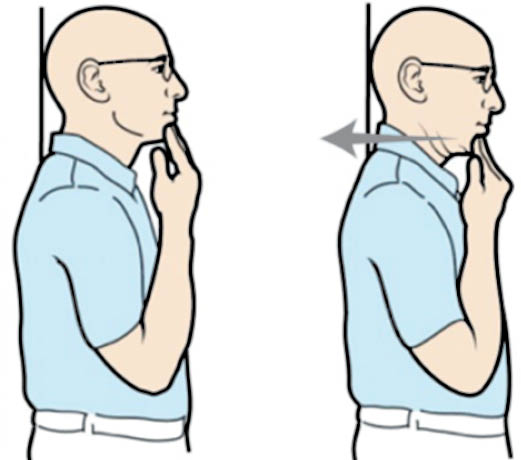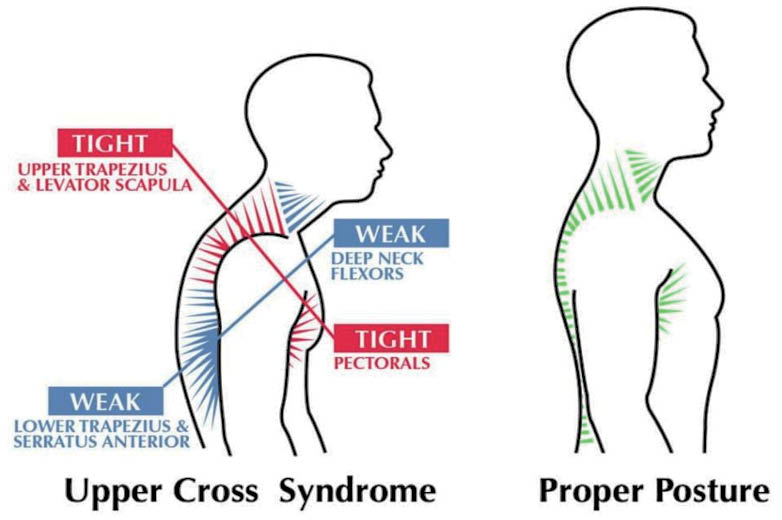Dr. Danesh D. Chinoy is a leading Health and Wellness Coach, Sports Physiotherapist and Psychologist. He is dedicated to helping all to heal holistically and remain fighting fit for life. You can connect with him at: daneshchinoy@gmail.com]
 Do you find that you’re always being asked to sit up straight? Do you complain of shoulder pain and/or neck pain often? Scared you’re developing a hunchback? If you’re nodding yes to these questions, chances are you may have ‘Upper Crossed Syndrome’ (UCS). This is a muscle imbalance that occurs in the neck and shoulders. It is often found in people who have desk jobs and sit with poor posture for most of the day which leads to having weak neck flexors along with weak lower trapezius muscles (which form a straight line when looking from the side) and tight upper trapezius along with tight pectoral muscles (forming the cross when looking from the side). Wow! That’s a lot of tension bands being crossed!
Do you find that you’re always being asked to sit up straight? Do you complain of shoulder pain and/or neck pain often? Scared you’re developing a hunchback? If you’re nodding yes to these questions, chances are you may have ‘Upper Crossed Syndrome’ (UCS). This is a muscle imbalance that occurs in the neck and shoulders. It is often found in people who have desk jobs and sit with poor posture for most of the day which leads to having weak neck flexors along with weak lower trapezius muscles (which form a straight line when looking from the side) and tight upper trapezius along with tight pectoral muscles (forming the cross when looking from the side). Wow! That’s a lot of tension bands being crossed!
UCS causes a person’s head to seemingly stoop forward, their upper back to appear hunched, and their shoulders and neck to hurt often. Thus, people struggling with this condition normally appear stooped over with rounded shoulders. This is because the deformed muscles put strain on the surrounding joints, bones, muscles and tendons.
Some symptoms that most commonly accompany UCS include Headache; Neck pain; Weakness in the front of the neck; Strain in the back of the neck; Pain in the upper back and shoulders, as well as the lower back; Tightness and pain in the chest; Trouble with sitting to read or watch TV; Trouble driving for long periods; Pain and reduced movement in the ribs; Restricted movements in the neck or shoulders; and Numbness, tingling, and pain in the upper arms.
Physiotherapy is the best option to treat UCS. Not only does physiotherapy relieve pain symptoms, it also eliminates underlying causes for the pain. You’d be surprised with how quickly your body gets relieved of the pain once it regains its natural shape and strength.
Your physiotherapist will create a custom treatment plan that will address your pain levels as well as your symptoms. Typically, your treatment plan will be divided into three parts – stretching the upper trapezius and pectoral muscles; strengthening the cervical (neck) flexors and lower trapezius muscles; and training you to make postural adjustments throughout the day to avoid future recurrence. To increase the flexibility of the muscles and joints and ensure full range of motion, there are muscular adhesions and trigger points that must be removed. Manual treatment should be followed by specific strengthening and stretching exercises to prevent future injury and to further restore strength and function.
It seems like a lot, but don’t worry! It’s just a matter of time and discipline to get back your posture and live pain-free!
Stretching: In UCS, the first thing to focus on is restoring shortened muscles. When one muscle is tightened or shortened, the opposite muscle needs to lengthen. Physiotherapists recommend a series of stretches and other therapies, like myofascial release and soft tissue mobilisation, to lengthen the upper trapezius and pectoral muscles back to its length.
Strengthening: Strengthening exercises in your treatment plan will target the cervical flexors and lower trapezius muscles. The most basic exercise is one called the ‘chin tuck’. Your physical therapist will instruct you to lay on your back with your knees bent, without a pillow to support your head. Next, bring your chin as close to your neck as possible, while keeping the back of your head on the floor and your mouth closed. Keeping your head straight, hold this position for 10 seconds, 10 to 12 times. You could do this same exercise in sitting or standing posture in front of the mirror and try tucking the chin. This is a most important exercise that you could do at home by yourself as well, so you can continue to make progress outside of your session appointments.
Postural Correction: You can do hours upon hours of stretching and strengthening exercises, but it’ll be for nothing if you don’t address your posture! This is what landed you with UCS in the first place. To address it, practice standing with your back and the back of your head against a wall. Your feet should be about six inches or so from the wall. Your neck should be two fingers-width from the wall. This is a fast and easy way to remind yourself what it feels like to stand up straight and have proper posture. Think of it as a way to retrain your body to know when it’s slouching. You can also get a standing desk or adjust your own desk to be raised up a bit to allow for a more neutral posture sitting position. Pay attention to your posture as you text or type.
Many people think it is best to sleep sideways. This is simply not true. If you have upper back and neck pain or headaches, sleeping on your side is often an overlooked cause of these conditions. For many, it is best to sleep on your back. Sleeping on your back is often difficult at first, so start by laying on your back for 20 minutes before bed at night. Place one or two pillows behind your knees and add some support under the curve of your neck and lower back. Roll up a hand towel to about the size of your wrist to create the support. Pregnant women and some patients with sleep apnoea are advised not to sleep on their back at night. They should continue to sleep on their side.
Side sleeping with a support between the knees is okay for your lumbar spine and pelvis, but it can often lead to shoulder and neck problems. If you are a side sleeper, make sure you have proper support between your head and the pillow so you do not kink your neck all night long. Also, be sure to keep your arms in front of you and do not reach overhead all night long. Reaching overhead for long periods of time is hard on the shoulder.
The Worst Sleep Position: Sleeping on your stomach is the worst! Notice when you sleep on your stomach how rotated the neck is – sleeping like this causes tension and stiffness in the neck.
If you think you’re experiencing pain and limited range of motion associated with UCS, don’t wait to get treated. This is a condition that may worsen over time. Treatment can quickly and safely resolve the source of this pain, while giving you the tools and knowledge you need to stay pain free. Live pain free and live strong!
- Anatomy, Physiology And Physiotherapy: The Wacky World Inside You - 20 April2024
- Beyond Numbers: Being Kind To Your Body Post-40 - 16 March2024
- Marvels Of Lymphatic Drainage Demystified - 25 November2023
